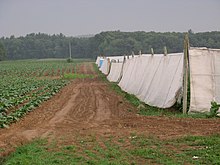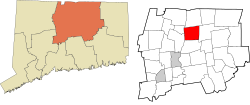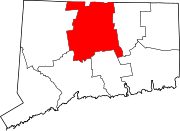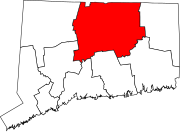East Windsor, Connecticut
East Windsor, Connecticut | |
|---|---|
Town | |
| Town of East Windsor | |
 The dam and Opera House in the Broad Brook section of town | |
| Nickname: East Side/East Borough/E-Dubb | |
| Motto(s): Unity, Strength | |
| Coordinates: 41°55′00″N 72°33′28″W / 41.91667°N 72.55778°W | |
| Country | |
| U.S. state | |
| County | Hartford |
| Region | Capitol Region |
| Settled | 1680 |
| Incorporated | 1768 |
| Villages | Broad Brook Melrose Scantic Warehouse Point Windsorville |
| Government | |
| • Type | Selectman-town meeting |
| • First Selectman | Jason E. Bowsza (D) |
| • Selectmen | Marie DeSousa (D) Alan Baker (D) Sarah Muska (R) Charlie Nordell (R) |
| Area | |
• Total | 26.8 sq mi (69.5 km2) |
| • Land | 26.3 sq mi (68.0 km2) |
| • Water | 0.6 sq mi (1.5 km2) |
| Elevation | 49 ft (15 m) |
| Population (2020) | |
• Total | 11,190 |
| • Density | 420/sq mi (160/km2) |
| Time zone | UTC-5 (Eastern) |
| • Summer (DST) | UTC-4 (Eastern) |
| ZIP Codes | 06016, 06088 |
| Area code(s) | 860/959 |
| FIPS code | 09-24800 |
| GNIS feature ID | 0212329[1] |
| Major highways | |
| U.S. Routes | |
| Website | www |
East Windsor is a town in Hartford County, Connecticut, United States. The town is part of the Capitol Planning Region. The population was 11,190 at the 2020 census.[2] The town has five villages: Broad Brook, Melrose, Scantic, Warehouse Point and Windsorville.
History
[edit]In 1633, Settlers laid claim to the area now known as Windsor, which included East Windsor. No English settlers lived on the east side of the river. The first English settler in what is today known as East Windsor, was William Pynchon, the founder of Springfield, Massachusetts. In 1636, he erected a warehouse for his settlement's transshipment of goods at what is now known as "Warehouse Point". Warehouse Point served as the southern border of Springfield, Massachusetts, for 132 years—until 1768—when Warehouse Point, Connecticut, was annexed by the Connecticut Colony. Pynchon selected the site of Warehouse Point because of its location near the Enfield Falls—the first major falls in the Connecticut River, the head of navigation where seagoing vessels were forced to terminate their voyages and transship to smaller shallops. By constructing a warehouse at Warehouse Point, Pynchon essentially forced all northern Connecticut River business to run through him and his settlement at Springfield.
Meanwhile, most of today's East Windsor was part of the prominent Windsor settlement on the east side of the river. Settlers avoided the East Side of the river due to the Podunk tribe who inhabited the area, particularly following King Philip's War in 1675. Simon Wolcott was the first settler in today's East Windsor. East Windsor also included today's Ellington and South Windsor. Eventually on May 10, 1768, The East Windsor parish was partitioned from Windsor. The center of town became what is now East Windsor Hill in today's South Windsor. The North Part of town center was Scantic.
In 1818, resident Solomon Ellsworth Jr, was blasting a hole for a well alongside his house in town. While in the process, he found some odd bones. These bones would later be sent to Yale University and eventually be identified as Dinosaur fossils, specifically one of an Anchisaurus. Though not the first fossils to be found, their discovery led to the dinosaur discovery craze later in the century as these were the first bones to be known as a dinosaur, four years before William Buckland determined it. The bones are still at Yale and the Ellsworth Homestead still stands on Rye Street near the South Windsor line.
In 1832, the Broad Brook Mill was created at the waterfall of the Mill Pond.
The town has five sections of town, Warehouse Point, Broad Brook, Scantic, Melrose, and Windsorville. The oldest section of town is Warehouse Point, which, as mentioned, was first used by William Pynchon in the 1630s, and later settled as part of Springfield in the 1680s. The Scantic section of town was the center of town until the mills were built. The Windsorville section of town was once its own community, featuring a church, post office, mini-mart, and a park. Mulnite Farms is a tobacco farm on Graham Road, established in 1905. In 1897, the town's voluntary fire department was created in the mill. The Broad Brook Elementary school was established in 1951. In 1961, the town hall burned down. The new town hall is on Rye Street, across from the elementary school. The new volunteer fire department building and senior center was built on the same site of the old town hall. On Memorial Day Weekend 1986, the Broad Brook Mill caught on fire during renovations, with the mill and the tire shop (on the site of the mill) burned down and the smoke being seen as far as Bradley International Airport and Hartford. A new mini strip mall was built on the site of the mill.
Geography
[edit]According to the United States Census Bureau, the town has a total area of 26.8 square miles (69.5 km2), of which 26.3 square miles (68.0 km2) is land and 0.58 square miles (1.5 km2), or 2.11%, is water.[3]

East Windsor is bordered by the town of Enfield to the north, South Windsor to the south, Ellington to the east, and Windsor Locks and Windsor to the west, across the Connecticut River.
By virtue of its location on the Connecticut River, Windsor functioned as a vital port. Merchants on both sides of the river shipped timber products, brick, livestock, wheat, tobacco and other produce to supply plantations in the West Indies, importing sugar, molasses, salt, and British manufactured textiles, ceramics, hardware and glass on return trips. Windsor's Hooker and Chaffee mercantile firm maintained a store and packing houses right off Windsor's Palisado Green. Small scale shipbuilding took place at the mouth of the Scantic River in what is now South Windsor, Warehouse Point in what is now East Windsor, and along the Farmington from as far upriver as today's village of Poquonock.[citation needed]
Demographics
[edit]| Census | Pop. | Note | %± |
|---|---|---|---|
| 1820 | 3,400 | — | |
| 1840 | 3,600 | — | |
| 1850 | 2,633 | −26.9% | |
| 1860 | 2,580 | −2.0% | |
| 1870 | 2,882 | 11.7% | |
| 1880 | 3,019 | 4.8% | |
| 1890 | 2,890 | −4.3% | |
| 1900 | 3,158 | 9.3% | |
| 1910 | 3,362 | 6.5% | |
| 1920 | 3,741 | 11.3% | |
| 1930 | 3,815 | 2.0% | |
| 1940 | 3,967 | 4.0% | |
| 1950 | 4,859 | 22.5% | |
| 1960 | 7,500 | 54.4% | |
| 1970 | 8,513 | 13.5% | |
| 1980 | 8,925 | 4.8% | |
| 1990 | 10,081 | 13.0% | |
| 2000 | 9,818 | −2.6% | |
| 2010 | 11,162 | 13.7% | |
| 2020 | 11,190 | 0.3% | |
| U.S. Decennial Census[4] | |||
As of the census[5] of 2000, there were 9,818 people, 4,078 households, and 2,556 families residing in the town. The population density was 373.5 inhabitants per square mile (144.2/km2). There were 4,356 housing units at an average density of 165.7 per square mile (64.0/km2). The racial makeup of the town was 91.47% White, 4.09% African American, 0.16% Native American, 2.00% Asian, 0.04% Pacific Islander, 0.83% from other races, and 1.41% from two or more races. Hispanic or Latino of any race were 2.11% of the population.
There were 4,078 households, out of which 27.5% had children under the age of 18 living with them, 48.7% were married couples living together, 10.1% had a female householder with no husband present, and 37.3% were non-families. 30.0% of all households were made up of individuals, and 9.5% had someone living alone who was 65 years of age or older. The average household size was 2.34 and the average family size was 2.94.
In the town, the population was spread out, with 22.2% under the age of 18, 6.2% from 18 to 24, 33.1% from 25 to 44, 23.8% from 45 to 64, and 14.7% who were 65 years of age or older. The median age was 39 years. For every 100 females, there were 96.4 males. For every 100 females age 18 and over, there were 92.6 males.
The median income for a household in the town was $51,092, and the median income for a family was $60,694. Males had a median income of $39,785 versus $33,446 for females. The per capita income for the town was $24,899. About 3.5% of families and 4.1% of the population were below the poverty line, including 2.9% of those under age 18 and 4.6% of those age 65 or over.
Government and politics
[edit]| Voter Registration and Party Enrollment as of October 30, 2012[6] | |||||
|---|---|---|---|---|---|
| Party | Active Voters | Inactive Voters | Total Voters | Percentage | |
| Democratic | 2,369 | 106 | 2,475 | 31.94% | |
| Republican | 1,460 | 48 | 1,508 | 19.46% | |
| Unaffiliated | 3,499 | 218 | 3,717 | 47.96% | |
| Minor parties | 49 | 1 | 50 | 0.65% | |
| Total | 7,377 | 373 | 7,750 | 100% | |
Elections
[edit]| Year | Democratic | Republican | Third Parties |
|---|---|---|---|
| 2020 | 53.22% 3,008 | 44.96% 2,541 | 1.82% 103 |
| 2016 | 46.05% 2,441 | 49.16% 2,606 | 4.79% 254 |
| 2012 | 56.84% 2,857 | 42.02% 2,112 | 1.13% 57 |
| 2008 | 58.81% 3,106 | 39.77% 2,100 | 1.42% 75 |
| 2004 | 54.34% 2,571 | 43.84% 2,074 | 1.82% 86 |
| 2000 | 54.60% 2,313 | 39.50% 1,673 | 5.90% 250 |
| 1996 | 52.42% 2,104 | 32.26% 1,295 | 15.32% 615 |
| 1992 | 39.25% 1,891 | 33.17% 1,598 | 27.58% 1,329 |
| 1988 | 48.36% 1,940 | 50.52% 2,027 | 1.12% 45 |
| 1984 | 38.45% 1,454 | 61.26% 2,317 | 0.29% 11 |
| 1980 | 41.82% 1,572 | 43.31% 1,628 | 14.87% 559 |
| 1976 | 53.26% 1,926 | 46.29% 1,674 | 0.44% 16 |
| 1972 | 44.48% 1,536 | 54.24% 1,873 | 1.27% 44 |
| 1968 | 50.22% 1,595 | 42.79% 1,359 | 6.99% 222 |
| 1964 | 69.37% 2,172 | 30.63% 959 | 0.00% 0 |
| 1960 | 54.28% 1,673 | 45.72% 1,409 | 0.00% 0 |
| 1956 | 37.15% 1,039 | 62.85% 1,758 | 0.00% 0 |
| Year | Office | Results |
|---|---|---|
| 2018 | Governor | Stefanowski 52.06–41.47% |
| U.S. Senator | Murphy 52.44–46.50% | |
| U.S. Representative | Larson 53.54–45.15% | |
| 2016 | President | Trump 49.16–46.05% |
| U.S. Senator | Blumenthal 58.72–38.88% | |
| U.S. Representative | Larson 54.91–42.65% | |
| 2014 | Governor | Foley 53.71–44.71% |
| U.S. Representative | Larson 54.57–43.42% | |
| 2012 | President | Obama 56.8–42.0% |
| U.S. Senator | Murphy 52.3–45.4% | |
| U.S. Representative | Larson 65.1–32.7% | |
| 2010 | Governor | Foley 56.0–42.0% |
| U.S. Senator | Blumenthal 50.7–47.4% | |
| U.S. Representative | Larson 53.1–45.3% | |
| 2008 | President | Obama 58.8–39.8% |
| U.S. Representative | Larson 69.6–27.1% | |
| 2006 | Governor | Rell 63.8–34.7% |
| U.S. Senator | Lieberman 46.8–39.8–12.5% | |
| U.S. Representative | Larson 71.7–28.3% | |
| 2004 | President | Kerry 54.3–43.8% |
| U.S. Senator | Dodd 66.8–31.1% | |
| U.S. Representative | Larson 56.8–43.2% |
Education
[edit]Elementary
[edit]East Windsor Elementary School System serves students in pre-kindergarten through grade four. The Connecticut Children's Place runs from grade five through grade 12. Its principal is Joyce Welch. Homebound schooling runs from Pre-K through 12. The Broad Brook Elementary School principal is Laura Foxx.
Middle school
[edit]East Windsor Middle School serves students in grades five through eight. Its principal is Timothy Field.
High school
[edit]East Windsor High School serves students in grades nine through twelve. Its principal is Allison Anderson.
Transportation
[edit]U.S. Route 5 runs through the town from the border with South Windsor to Enfield.
East Windsor is halfway between Hartford and Springfield, each 12 miles (19 km) away. Interstate 91 serves East Windsor with exits 44 and 45. Windsor Locks station is the nearest passenger train station.
Bradley International Airport is 5 miles (8 km) away. Skylark Airport is a small airstrip to help young aviators learn how to fly.
Crime
[edit]
East Windsor crime, according to city-data.com[9] is relatively low against U.S. averages. Between 1999 and 2004, not including 2003, there was one murder, 26 rapes, 43 robberies, 41 assaults, 254 burglaries, 1248 thefts, and 177 car thefts.

Points of interest
[edit]- The Connecticut Trolley Museum and the Connecticut Fire Museum are located in the Warehouse Point section of town.
- The East Windsor Academy Museum operated by the historical society is located in the Scantic neighborhood.
- The East Windsor Hill section of the nearby town of South Windsor was the boyhood home of the theologian Jonathan Edwards.
- The Melrose School, now called the Melrose Library, is a one-room schoolhouse that was active until the early 20th century. It is located in the Melrose section of town and is now used for local functions.
- St. John's Episcopal Church (Warehouse Point, Connecticut) is on the National Register of Historic Places.
Notable people
[edit]- Lorrin Andrews, Congregational Church clergyman missionary to Hawaii, judge, and first Associate Justice of Hawaii State Supreme Court[10]
- John Warner Barber, engraver whose books of state, national, and local history featured his vivid engravings
- Israel Bissell, post-rider who alerted the colonists of the British attack on April 19, 1775
- Daniel Bissell, Soldier and spy for the Continental Army during the American Revolutionary War
- Samuel Robbins Brown, missionary to China and Japan with the Dutch Reformed Church
- Eliphalet Chapin, cabinetmaker and furniture maker
- Aaron Civale, pitcher for the Milwaukee Brewers
- Jonathan Edwards, theologian
- Frederick Holbrook, Governor of Vermont
- Jerry Marquis, former NASCAR driver
- Walter Loomis Newberry, businessman and philanthropist
- Ryan Preece, NASCAR driver
- Eli Terry, first inventor to receive a United States patent for a clock mechanism
- Lizabeth A. Turner (1829–1907), National President, Woman's Relief Corps
- Erastus Wolcott, 18th-century member of the Connecticut General Assembly representing East Windsor[11]
References
[edit]- ^ a b U.S. Geological Survey Geographic Names Information System: East Windsor, Connecticut
- ^ "Census - Geography Profile: East Windsor, Hartford County, Connecticut". Retrieved December 15, 2021.
- ^ "Geographic Identifiers: 2010 Demographic Profile Data (G001): East Windsor town, Hartford County, Connecticut". U.S. Census Bureau, American Factfinder. Archived from the original on February 12, 2020. Retrieved November 26, 2012.
- ^ "Census of Population and Housing". Census.gov. Retrieved June 4, 2015.
- ^ "U.S. Census website". United States Census Bureau. Retrieved January 31, 2008.
- ^ "Registration and Party Enrollment Statistics as of October 30, 2012" (PDF). Connecticut Secretary of State. Archived from the original (PDF) on October 30, 2012. Retrieved October 2, 2006.
- ^ "General Elections Statement of Vote 1922". CT.gov - Connecticut's Official State Website.
- ^ "Election Night Reporting". CT Secretary of State. Archived from the original on April 28, 2016. Retrieved May 1, 2021.
- ^ "East Windsor, Connecticut (CT 06016) profile: population, maps, real estate, averages, homes, statistics, relocation, travel, jobs, hospitals, schools, crime, moving, houses, news, sex offenders". www.city-data.com.
- ^ Who Was Who in America, Historical Volume, 1607-1896. Chicago: Marquis Who's Who. 1963.
- ^ Buel, Richard (1999). "Wolcott, Erastus (1722-1793), influential Connecticut political leader and judge". American National Biography. doi:10.1093/anb/9780198606697.article.0101002. ISBN 978-0-19-860669-7. Archived from the original on June 5, 2018. Retrieved February 20, 2021.
External links
[edit]![]() Media related to East Windsor, Connecticut at Wikimedia Commons
Media related to East Windsor, Connecticut at Wikimedia Commons









